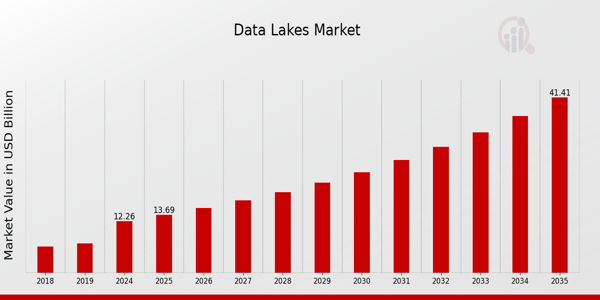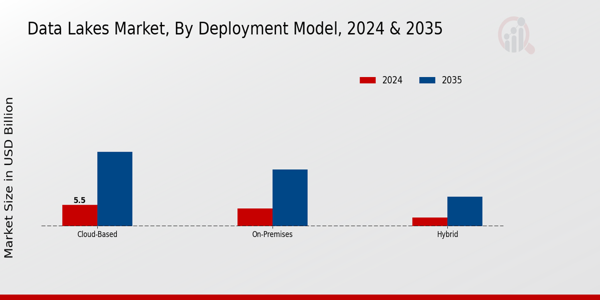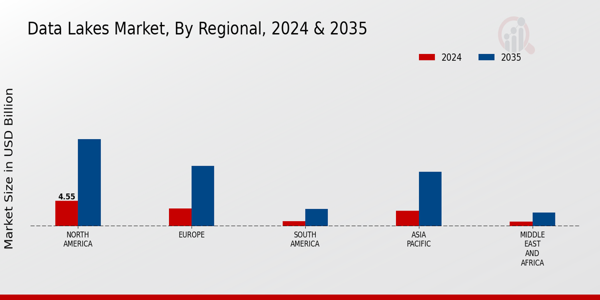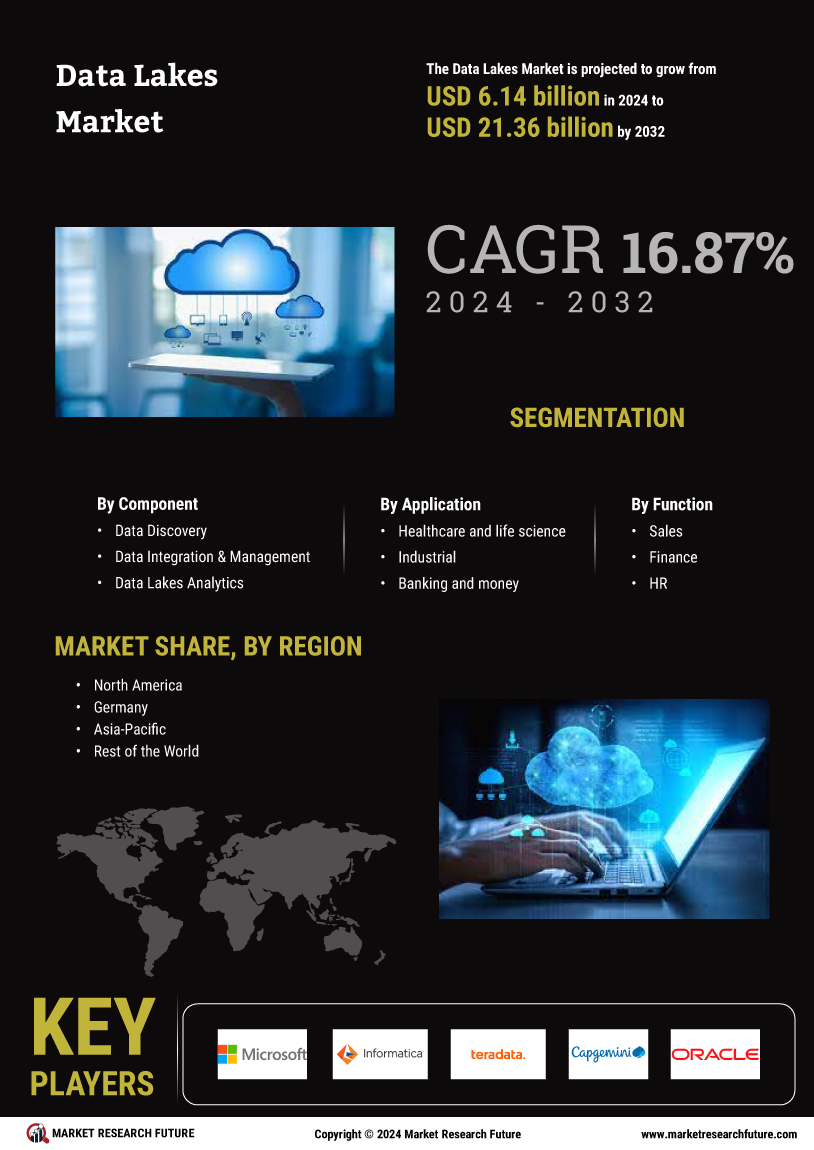Data Lakes Market Summary
As per Market Research Future analysis, the Data Lakes Market Size was estimated at 11.09 (USD Billion) in 2023.The Data Lakes Market Industry is expected to grow from 12.26 (USD Billion) in 2024 to 41.41 (USD Billion) by 2035. The Data Lakes Market CAGR (growth rate) is expected to be around 11.7 % during the forecast period (2025 - 2035). Key drivers include the rise of IoT devices, cloud adoption, and the need for real-time analytics, making data lakes essential for organizations seeking to leverage big data effectively.
Key Market Trends & Highlights
The Global Data Lakes Market is evolving rapidly, influenced by technological advancements and increasing data needs.
- Market size in 2024: 12.26 USD Billion; projected to grow to 41.41 USD Billion by 2035.
- CAGR from 2025 to 2035: 10.58%.
- North America to dominate with a valuation of 5.6 USD Billion in 2024, rising to 17.2 USD Billion by 2035.
- Cloud-Based solutions expected to grow from 7.78 USD Billion in 2024 to 23.0 USD Billion by 2035.
Market Size & Forecast
2024 Market Size: USD 12.26 Billion
2035 Market Size: USD 41.41 Billion
CAGR (2025-2035): 11.7%
Largest Regional Market Share in 2024: North America.
Major Players
IBM, Amazon Web Services, Microsoft, Snowflake, Teradata, Google, SAP, Dell Technologies, Cloudera, Oracle.
Key Data Lakes Market Trends Highlighted
The Data Lakes Market is currently being propelled by the growing necessity for organizations to effectively manage and analyze immense quantities of unstructured data. The demand for scalable storage solutions that can accommodate a wide range of data types is on the rise as businesses worldwide generate an unprecedented amount of data. The data explosion is considerably influenced by the proliferation of social media platforms and IoT devices, which are contributing to the surge in data creation.
Furthermore, the transition to data lakes is being further facilitated by the widespread adoption of cloud computing, as organizations pursue cost-effective and adaptable solutions for data storage and processing. Industries are acknowledging the potential of big data analytics to enhance operational efficiencies and decision-making, which presents an opportunity for exploration within the Data Lakes Market.
Companies can transform unstructured data into valuable insights by utilizing advanced analytics tools and artificial intelligence. Healthcare, finance, and retail sectors are particularly well-positioned to capitalize on this opportunity, as they can optimize their data management strategies and generate actionable intelligence to enhance operational performance and customer experiences.
The increasing emphasis on data governance and security within data lake environments has been a notable trend in recent years. Organizations are investing in comprehensive governance frameworks and security measures to safeguard sensitive information as concerns regarding data privacy and compliance continue to escalate. This trend is indicative of a more comprehensive understanding of the significance of ethical data practices in the context of regulatory compliance and consumer trust.
Ultimately, these trends represent a fundamental transition toward more responsible and strategic data management, which is driving more innovation and growth in the Data Lakes Market as it continues to evolve.

Source: Primary Research, Secondary Research, Market Research Future Database, and Analyst Review
Data Lakes Market Drivers
Increased Data Generation across Industries
The Data Lakes Market is experiencing significant growth due to the explosion of data generation across multiple sectors. A report by the International Data Corporation estimates that by 2025, the global data creation is expected to reach 175 zettabytes, which is nearly a 61 percent increase from 2018. As organizations like Google and Amazon continue to accumulate massive datasets, the need for robust data storage solutions, such as data lakes, becomes crucial.
These centralized repositories allow for flexible storage of structured, semi-structured, and unstructured data, thus enabling organizations to derive insights and make informed decisions based on real-time analytics. In addition, as businesses push for data-driven decision-making, the demand for data lakes as a scalable solution will escalate, facilitating the overall growth of the Data Lakes Market.
Adoption of Advanced Analytics and Machine Learning
The trend towards advanced analytics and machine learning is significantly driving the Data Lakes Market Industry. Enterprises are increasingly leveraging advanced analytics solutions to derive insights from large datasets, which are often housed in data lakes. According to McKinsey & Company, organizations that utilize data effectively can increase their profitability by up to 20 percent. This growing need for sophisticated data analysis fuels the demand for data lakes since they facilitate the storage of diverse data types required for training machine learning models.
With leading tech companies, such as IBM and Microsoft, investing heavily in artificial intelligence innovations, the integration of such technologies with data lakes will further enhance market prospects.
Cloud Adoption and Migration to Hybrid Solutions
The shift towards cloud computing and hybrid cloud solutions is revolutionizing the Data Lakes Market Industry. A study by the Cloud Security Alliance highlights that 94 percent of enterprises already use cloud services in some form, suggesting an increasing reliance on cloud infrastructures. This transition to the cloud allows organizations to store vast amounts of data and offers a flexible and cost-effective means of managing their data lakes.
Major cloud providers like Amazon Web Services and Google Cloud are continuously enhancing their offerings to include data lake services, which further accelerates the adoption of data lakes across the global landscape. This growing cloud presence contributes significantly to the expansion of the Data Lakes Market.
Data Lakes Market Segment Insights
Data Lakes Market Deployment Model Insights
The Deployment Model segment within the Data Lakes Market highlights the diversity in how organizations prefer to deploy their data lake solutions, reflecting varying needs, organizational sizes, and industry requirements. As of 2024, the overall market is projected to be valued at 12.26 USD billion, reflecting a robust demand for scalable and efficient data management.
Within this landscape, the On-Premises deployment model holds a valuation of 4.5 USD Billion, demonstrating significant utility for enterprises that prioritize security and have the necessary resources for infrastructure management. Organizations opting for On-Premises solutions often have stringent data governance policies and regulatory compliance needs, which make this deployment model a favorable choice.
In contrast, the Cloud-Based segment presents a growing opportunity, with a valuation of 5.5 USD Billion in 2024. The flexibility, scalability, and cost-effectiveness offered by cloud solutions resonate well with companies aiming to reduce capital expenditure while enjoying the benefit of continuous data integration and analytics capabilities.
Businesses are increasingly adopting Cloud-Based solutions due to the ease of access to large datasets and the rapid deployment capabilities that cloud environments provide, making this segment a significant driver of market growth moving forward.
The Hybrid deployment model, currently valued at 2.26 USD billion in 2024, plays a critical role in bridging the gap between on-premises and cloud solutions. Organizations utilizing Hybrid models can manage sensitive data on-site while leveraging the cloud's agility for less sensitive information, effectively optimizing resource allocation.
This approach allows enterprises to maintain data sovereignty while benefiting from the advanced analytical capabilities offered by cloud providers. As businesses increasingly seek to optimize their operations, the Hybrid model is gaining traction due to its versatility and ability to cater to diverse organizational needs.
As the Data Lakes Market continues to evolve, organizations are expected to navigate between these deployment options, balancing factors such as cost, performance, and compliance to drive their data strategy forward. Each deployment model serves its distinct purpose, influencing how data lakes are structured and utilized across industry sectors, thus propelling the overall market growth and evolving its segmentation landscape.

Source: Primary Research, Secondary Research, Market Research Future Database, and Analyst Review
Data Lakes Market Component Insights
The Data Lakes Market is experiencing substantial growth, driven by the increasing demand for efficient data storage and management solutions. By 2024, the market is projected to be valued at 12.26 billion USD, with significant contributions from various components.
Among these, storage solutions are essential as they provide the foundational infrastructure for data lakes, allowing organizations to securely retain large volumes of data. Data processing capabilities are also crucial, enabling businesses to convert raw data into actionable insights efficiently.
Data integration plays a vital role in ensuring seamless connectivity across diverse data sources, thereby enhancing overall data accessibility. Meanwhile, analytics is a key component that empowers organizations to derive meaningful insights from their data, facilitating informed decision-making processes.
The combination of these elements contributes to the broader Data Lakes Market revenue and its dynamics, representing a rapid evolution in handling big data. Emphasizing these components is vital, as they collectively address the growing challenges faced in data management while presenting numerous opportunities for innovation and improved operational efficiencies in the global landscape.
Data Lakes Market End-User Insights
The Data Lakes Market is experiencing significant growth with a valuation expected at 12.26 USD Billion in 2024 and projected to reach 41.41 USD Billion by 2035. The End-User segment plays a critical role in this expansion, encompassing key industries such as Banking, Financial Services, and Insurance (BFSI), Healthcare, Retail, IT and Telecommunication, and Manufacturing. The BFSI sector leverages data lakes to enhance risk management and compliance, while the Healthcare industry utilizes vast amounts of data for improved patient outcomes and operational efficiency.
Retailers are increasingly adopting data lakes for personalized marketing and inventory management, recognizing the value of consumer data insights. IT and Telecommunications utilize these solutions for service optimization and network performance analysis, driving customer satisfaction.
Manufacturing benefits from data lakes in predictive maintenance and supply chain optimization. Significant opportunities arise from evolving technologies and increasing data volume, creating a robust demand for effective data management solutions across these sectors.
The Data Lakes Market data shows that the adoption rate is accelerating, fueled by the growing need for organizations to harness data for strategic decision-making and competitive advantage. The market growth is primarily driven by the ongoing digital transformation initiatives in these industries, despite challenges like data security and integration complexities.
Data Lakes Market Organization Size Insights
The Data Lakes Market demonstrates a robust growth trajectory, expected to reach a valuation of 12.26 USD billion by 2024, and continuing to expand significantly through 2035. Within the Organization Size segmentation, Small Enterprises, Medium Enterprises, and Large Enterprises each play a distinct role in the market landscape.
Small Enterprises are increasingly adopting data lake technologies due to their cost-effectiveness and ability to harness data for better decision-making. Medium Enterprises are leveraging these solutions to enhance their data management capabilities, thus facilitating more informed strategies for growth.
Meanwhile, Large Enterprises dominate the market with substantial investments in data lakes, capitalizing on massive data volumes for business intelligence, trend analysis, and operational efficiency. The ability of Large Enterprises to integrate data lakes with advanced analytics technologies presents a crucial advantage in staying competitive.
Growth drivers in the Data Lakes Market include the rising demand for data integration and management solutions amid the digital transformation trend, whereby companies aim to derive actionable insights from their data assets.
However, challenges such as data governance and security continue to pose obstacles. Overall, the Data Lakes Market is enriched by diverse organization sizes that collectively contribute to its expanding ecosystem.
Data Lakes Market Regional Insights
The Data Lakes Market is showing significant regional variations in its valuation and growth potential. In 2024, North America leads the market with a valuation of 4.55 USD billion, projected to grow to 15.75 USD billion by 2035, showcasing its majority holding and dominance in data analytics and cloud solutions.
Europe follows with a valuation of 3.2 USD Billion in 2024, expected to reach 10.9 USD Billion in 2035, driven by the increasing adoption of data-driven decision-making across various industries. The Asia Pacific region, valued at 2.8 USD Billion in 2024 and growing to 9.8 USD billion in 2035, is experiencing a rapid digital transformation, making it a significant player in the Data Lakes Market.
South America, while smaller in size with values of 0.9 USD Billion and 3.1 USD billion for respective years, is gradually increasing its market presence as enterprises seek scalable data solutions. The Middle East and Africa hold the smallest market share with 0.81 USD billion in 2024 and 2.45 USD billion in 2035, yet the region is witnessing growing opportunities as businesses aim to enhance their data infrastructure. These market dynamics reflect how varying regional demands and technological advancements influence the Data Lakes Market’s segmentation and overall growth trajectory.

Source: Primary Research, Secondary Research, Market Research Future Database, and Analyst Review
Data Lakes Market Key Players and Competitive Insights
The Data Lakes Market is characterized by a dynamic landscape where various players vie for dominance through innovative technologies and services. As organizations increasingly recognize the value of consolidating their data into scalable storage solutions, the competition has intensified, with companies devising novel approaches to data management, analytics, and governance.
The market is not only growing in size but also evolving in complexity, as emerging trends such as artificial intelligence, machine learning, and real-time data processing shape its progression. Diverse companies are involved, each bringing unique capabilities to address different aspects of data lake management, creating a vibrant and competitive environment.
Oracle occupies a dominant position in the data lakes market by providing a unified data platform that seamlessly integrates structured and unstructured data. With its Oracle Cloud Infrastructure (OCI), it provides a high-performance, secure environment for the development, management, and scaling of data lakes. The ecosystem of Oracle is appealing to enterprises with complex workloads due to its support for a diverse selection of analytics, AI, and machine learning tools.
One of its significant advantages is its emphasis on data security, governance, and interoperability, which enables organizations to integrate conventional databases with big data frameworks such as Spark and Hadoop. Oracle also triumphs in hybrid and multi-cloud strategies, which provide a variety of deployment options. Oracle enables organizations to effectively convert unstructured data into actionable intelligence by leveraging its rich history in enterprise data management and innovation in cloud-native services.
Microsoft's Azure Data Lake platform, which offers secure and scalable cloud-based storage specifically designed for big data analytics, is the market leader in data lakes. Supporting services such as Azure Synapse Analytics and Power BI, it is profoundly integrated into the Azure ecosystem, facilitating seamless end-to-end data workflows. Microsoft's distinctive features include sophisticated security features, robust developer support, and ease of use.
Simple ingestion and transformation of data from a variety of sources are facilitated by the platform, thereby facilitating the development of comprehensive, real-time insights for enterprises. Support for a variety of programming languages and formats, as well as Microsoft's open-source friendliness, promotes widespread adoption. Microsoft is a trusted leader in the management and operationalization of massive data volumes due to its continuous investment in AI and data governance tools, strong enterprise relationships, and compliance credentials.
Key Companies in the Data Lakes Market Include
- Dremio
- Teradata
- Cloudera
- Hewlett-Packard Enterprise
- Oracle
- Microsoft
- IBM
- Google
- Microsoft Azure Data Lake
- Snowflake
- Amazon Web Services
- Hitachi Vantara
- SAP
- Dell Technologies
- Beyon
- Cloudian
Data Lakes Market Industry Developments
The Data Lakes Market has seen notable developments in recent months, particularly with advancements from companies such as Dremio, Tableau, and Snowflake.
In August 2024, Cloudian and Lenovo introduced the HyperStore AI data lake platform, which is specifically designed for artificial intelligence (AI) workloads and offers improved performance and power efficiency. This solution, which is based on Lenovo's ThinkSystem SR635 V3 all-flash servers, is designed to address the increasing demand for secure and scalable systems that are capable of administering next-generation AI tasks.
LigaData, an innovative data analytics and cloud firm situated in Silicon Valley, California, has entered into a partnership with Beyon as of August 2024. The partnership would establish a state-of-the-art Data Lakehouse, which would serve as a centralized center for all data owned by the Beyon Group. The objective of this strategic initiative is to enhance Beyon's data infrastructure for the future by leveraging the numerous benefits of advanced cloud technologies. Source: https://www.mordorintelligence.com/industry-reports/data-lakes-market
Over the past two years, the surge in digital transformation initiatives across industries has continually highlighted the importance of data lakes. Companies like Teradata and Dell Technologies are actively investing in Research and Development to address and leverage the capabilities of data lakes in a rapidly evolving data landscape.
Data Lakes Market Segmentation Insights
-
Data Lakes Market Deployment Model Outlook
- On-Premises
- Cloud-Based
- Hybrid
-
Data Lakes Market Component Outlook
- Storage
- Data Processing
- Data Integration
- Analytics
-
Data Lakes Market End-User Outlook
- BFSI
- Healthcare
- Retail
- ITTelecommunication
- Manufacturing
-
Data Lakes Market Organization Size Outlook
- Small Enterprises
- Medium Enterprises
- Large Enterprises
-
Data Lakes Market Regional Outlook
- North America
- Europe
- South America
- Asia Pacific
- Middle East and Africa
|
Report Attribute/Metric
|
Details
|
|
Market Size 2023
|
11.09(USD Billion)
|
|
Market Size 2024
|
12.26(USD Billion)
|
|
Market Size 2035
|
41.41(USD Billion)
|
|
Compound Annual Growth Rate (CAGR)
|
11.7% (2025 - 2035)
|
|
Report Coverage
|
Revenue Forecast, Competitive Landscape, Growth Factors, and Trends
|
|
Base Year
|
2024
|
|
Market Forecast Period
|
2025 - 2035
|
|
Historical Data
|
2019 - 2024
|
|
Market Forecast Units
|
USD Billion
|
|
Key Companies Profiled
|
Dremio, Teradata, Cloudera, Hewlett-Packard Enterprise, Oracle, Microsoft, IBM, Google, Microsoft Azure Data Lake, Snowflake, Amazon Web Services, Hitachi Vantara, SAP, Dell Technologies
|
|
Segments Covered
|
Deployment Model, Component, End-User, Organization Size, Regional
|
|
Key Market Opportunities
|
Integration with AI technologies, increasing demand for real-time analytics, Expansion in IoT data storage, growing focus on data governance, rising adoption of cloud-based solutions
|
|
Key Market Dynamics
|
Increasing data volume, Adoption of cloud services, Demand for real-time analytics, Data integration challenges, Cost-effective storage solutions
|
|
Countries Covered
|
North America, Europe, APAC, South America, MEA
|
Data Lakes Market Highlights:
Frequently Asked Questions (FAQ):
The Data Lakes Market is expected to be valued at 12.26 billion USD in 2024.
By 2035, the Data Lakes Market is anticipated to reach a value of 41.41 billion USD.
The expected CAGR for the Data Lakes Market during the forecast period is 11.7%.
North America is projected to dominate the market with a valuation of 15.75 billion USD by 2035.
In 2024, the market size of the Data Lakes Market in Europe is valued at 3.2 billion USD.
In 2024, the cloud-based deployment model is valued at 5.5 billion USD and the on-premises model at 4.5 billion USD.
Some key players in the Data Lakes Market include Microsoft, Oracle, IBM, and Amazon Web Services.
The hybrid deployment model is projected to reach a market value of 7.5 billion USD by 2035.
The Asia Pacific region is expected to experience notable growth, reaching a market value of 9.8 billion USD by 2035.
The market faces challenges related to data security while presenting opportunities in analytics and big data integration.

















